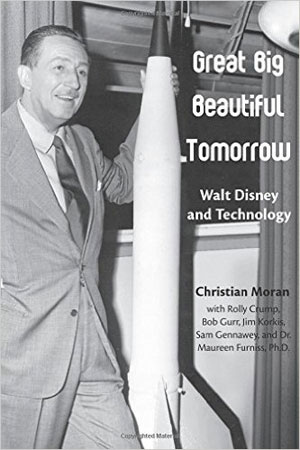
Walt Disney is most commonly remembered for the creation of Mickey Mouse, animated classics like Snow White and Cinderella, and the original Disneyland. He’s become a larger-than-life legend who’s referenced constantly by fans and Disney leaders when discussing everything connected to the brand. It’s easy to look upon Walt as an abstract idea more than a guy who achieved remarkable feats.
There were plenty of obstacles to overcome during the growth of Disney into the massive company we know today. One reason for their success was a series of technological advances that separated Disney from the pack. These weren’t just minor upgrades; the breakthroughs completely altered the entertainment landscape.
These accomplishments are the focus of Christian Moran’s book Great Big Beautiful Tomorrow, released in May by Theme Park Press. A companion piece to his upcoming documentary, it takes us through Walt’s history and chronicles the reasons for Disney’s success. The text includes contributions from authors Sam Gennawey and Jim Korkis, former Imagineers Rolly Crump and Bob Gurr, and professor and historian Dr. Maureen Furniss.
Their comments structure this book more like an oral history than your typical look at Disney’s past. Moran begins each chapter with his own thoughts and then mixes them with the others’ content. Given the connections with the impending film, it makes sense to set up this book more like a documentary.
Disney’s Early Space Gems
The most interesting sections provide considerable details about Walt’s creative process. A prime example is the chapter on the “Tomorrowland” episodes of the Disneyland TV series. Moran incorporates some comments from Korkis but also provides a lot of material on those classic shows.
Chaired by Ward Kimball, the Man in Space pieces remain stunning when viewed today. Incorporating animation and live interviews, they set the stage for the space program in the years to follow. The reason this chapter stands out is the way that Moran delves into the story and provides content that goes beyond what many of us know. This is also true in his chapters on the 1964-65 New York World’s Fair and the look at Walt’s plans for EPCOT.
The book’s second half is where the predominant theme takes over, and that approach corresponds with the best material. One reason is just how much happened at Disney in the ‘50s and ‘60s. The opening of Disneyland and Walt’s growing interest in technology create fascinating material for enthusiasts like me. The achievements in animation with Snow White and Fantasia were also impressive.
A Great Big Beautiful Tomorrow
What makes the latter segments click is the feeling that Walt and his team were inventing a whole new genre. Gennawey says it best: “The world would be a much different place if it weren’t for Disneyland.” From an urban planning perspective, Walt did more than create an incredible theme park.
It’s easy to get wrapped up in heaping praise on Walt’s accomplishments, and Moran veers a bit too much into that territory. The introduction takes a surprising approach of focusing on attacks that Walt was a sexist and a racist, among other things. For a book aimed at technological achievements, it’s unexpected to start with a defense of criticisms against Walt. That said, I can understand what Moran is trying to do.
His simple question to the contributors at the book’s end asks “How should we remember Walt Disney?” It seems basic, but the inquiry leads to some heartfelt responses from the group. They all focus on the idea that he wasn’t a perfect guy, which was fine. Hearing about his grumpiness and other issues makes him feel real. It also solidifies the achievements because he was fallible like the rest of us.
Looking Beyond Walt Disney and Technology
Great Big Beautiful Tomorrow expands beyond the technology, particularly in the early pages. The chapter on the brutal labor strike is a slight detour and tells a more straightforward history. The details should be familiar to Disney fans, but they fit within the narrative. One thing to mention is the lack of citations or a complete bibliography. Those sections can be a helpful way to learn more details on a topic. The book is only about 140 pages, so I recognize the space limitations in this format.
The book functions more like a breezy narrative than a reference guide, with the panel’s contributions elevating the material. Crump and Gurr are originals who always have so much to say, and Gennawey’s an expert who’s written three great books on Disney. Moran keeps everything flowing with content that isn’t too dense for non-experts. He’s clearly a fan and enthusiastic about Disney history. The stories are familiar, but it’s a different spin on the usual tale.
To learn more about Great Big Beautiful Tomorrow, visit the Theme Park Press site.
Related Articles: Great Big Beautiful Tomorrow
Review: True-Life Adventures by Christian Moran
Listen to The Tomorrow Society Podcast, Episode 29: Christian Moran, Author of True-Life Adventures
This post contains affiliate links. Making any purchase through those links supports this site. See full disclosure.



Thanks for reviewing this book, it’s been on my Amazon wish list for about a month and I’ll be ordering it soon.
I’ve always been fascinated by Walt’s desire to push the limits of technology in so many different fields. It’s fun to think about what he could have accomplished if had lived another 10-15 years.
Ron, I expect that the trajectory of Walt Disney World might have been very different if Walt had lived even another 5-10 years. It’s an intriguing topic, and it would have been fascinating to see how things would have gone with EPCOT in particular.